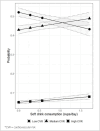Association between soft drink consumption and cardiovascular disease risk among Brazilian adults: a cross-sectional study
- PMID: 40834162
- PMCID: PMC12377782
- DOI: 10.1590/1516-3180.2023.0433.R1.29112024
Association between soft drink consumption and cardiovascular disease risk among Brazilian adults: a cross-sectional study
Abstract
Background: Inadequate diet is considered a major risk factor for chronic noncommunicable diseases and mortality. Among the ultra-processed foods, sweetened soft drinks are significant contributors to high-calorie diets and are associated with adverse health outcomes.
Objective: To estimate the association between soft drink consumption and the risk of cardiovascular events.
Design and setting: A cross-sectional study was conducted using data of adults aged ≥ 18 years from the 2013 National Health Survey.
Methods: The explanatory variable was the daily consumption of sugar-sweetened soft drinks. Cardiovascular risk (CVR) was calculated using the Framingham score. Multinomial logistic regression was used for the analyses. Two models were used: one adjusted for age and body mass index and the other for age and waist circumference. Both models were applied to the general population and stratified by race and educational attainment.
Results: The study sample consisted of 8,391 participants. Individuals with sugary soda consumption ≥ 0.4 cups/day were associated with a higher CVR, which escalated with increasing consumption of soft drinks.
Conclusions: CVR was observed across all consumption categories and difference in risk was based on the intake quantity.
Conflict of interest statement
Figures


Similar articles
-
Association of sugary drinks, carbonated beverages, vegetable and fruit juices, sweetened and black coffee, and green tea with subsequent depression: A five-year cohort study.Clin Nutr. 2024 Jun;43(6):1395-1404. doi: 10.1016/j.clnu.2024.04.017. Epub 2024 Apr 17. Clin Nutr. 2024. PMID: 38691982
-
The burden of cardiovascular disease in adolescents in China and globally due to sugar-sweetened beverage consumption from 1990 to 2021: results from the global burden of disease study 2021.BMC Public Health. 2025 Aug 15;25(1):2788. doi: 10.1186/s12889-025-24160-7. BMC Public Health. 2025. PMID: 40817052 Free PMC article.
-
Effects of a gluten-reduced or gluten-free diet for the primary prevention of cardiovascular disease.Cochrane Database Syst Rev. 2022 Feb 24;2(2):CD013556. doi: 10.1002/14651858.CD013556.pub2. Cochrane Database Syst Rev. 2022. PMID: 35199850 Free PMC article.
-
Association between sugar-sweetened and artificially sweetened soft drinks and type 2 diabetes: systematic review and dose-response meta-analysis of prospective studies.Br J Nutr. 2014 Sep 14;112(5):725-34. doi: 10.1017/S0007114514001329. Epub 2014 Jun 16. Br J Nutr. 2014. PMID: 24932880
-
Association between tax on sugar sweetened beverages and soft drink consumption in adults in Mexico: open cohort longitudinal analysis of Health Workers Cohort Study.BMJ. 2020 May 6;369:m1311. doi: 10.1136/bmj.m1311. BMJ. 2020. PMID: 32376605 Free PMC article.
References
-
- Brasil . VIGITEL Brazil 2021 Surveillance of Risk and Protective Factors for Chronic Diseases by Telephone Survey. 1st ed. Brasília: Ministério da Saúde; 2022. [April 4 2025]. Available from: https://www.gov.br/saude/pt-br/centrais-de-conteudo/publicacoes/svsa/vi... .
MeSH terms
LinkOut - more resources
Full Text Sources

